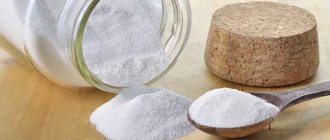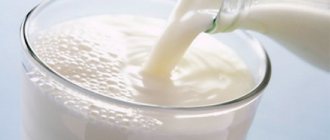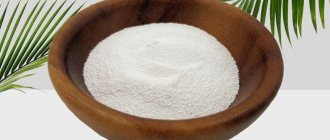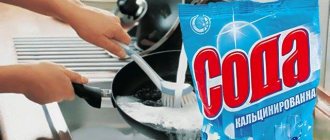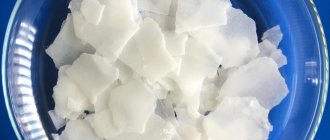What is crystal soda
Crystalline soda is a mineral substance consisting of molecules of sodium carbonates Na2CO3, NaHCO3. In nature, soda exists in three main forms:
- Food grade – sodium bicarbonate NaHCO3, which is a fine white powder without a specific odor. From an electrolytic point of view, a substance has an ionic crystal lattice, and is therefore depicted as an ion pair:
- Caustic - alkali NaOH (caustic soda), is a large white crystals.
- Calcined - sodium carbonate Na2CO3, exists in the form of large white crystals.
From a chemical point of view, the formula of crystalline soda is defined as crystalline hydrate Na2CO3*10H2O.
Methods for producing sodium carbonate
The need for soda ash cannot be met using only natural sources. The following methods have been developed for production in industrial quantities:
- Solvay method.
- Howe's method.
The first method was patented by the Belgian chemist Ernest Solvay. This option is considered more economical and less labor-intensive than previously used methods. The process of obtaining the finished product includes several stages.
Formation of sodium bicarbonate:
NH3 + CO2 + H2O + NaCI → NaHCO3 + NH4Cl
Separation of the sodium salt precipitate and subsequent change in the mark on the thermometer to 140-160˚C.
NaHCO3 → Na2CO3 + CO2 + H2O
The products formed during the described reactions are reused. Carbon dioxide is captured, and ammonium chloride is pre-treated with calcium hydroxide to decompose into ammonia and water.
NH4Cl + Ca(OH)2 → CaCl2 + 2NH3 + 2H2O
Calcium chloride (CaCl2) is the only product that is removed from the system.
Howe's method is considered a modification of the previous method. It differs in that ammonium chloride is not used to regenerate ammonia, but is removed from the process.
The product is widely used as a fertilizer for growing rice, since excess chlorine does not have a negative effect on this cereal. The process of obtaining a substance is described by the following equations:
NH3 + CO2 + H2O + NaCl → NaHCO3 + NH4Cl
NaHCO3 → Na2CO3 + CO2 + H2O
The sodium chloride solution is heated to 40C, carbon dioxide and ammonia gas are passed through it. The intermediate sodium bicarbonate is isolated from a cooled solution (10˚C) due to the low solubility of the compound and heated to 140-160˚C. The result is dehydration and removal of excess carbon monoxide (IV).
In laboratory practice, other methods of obtaining are used:
- Na2O + CO2 → Na2CO3 – mixing sodium oxide with carbon monoxide (IV);
- 2NaOH + CO 2 → Na2CO3↓ + H2O – passing carbon dioxide through a solution of sodium hydroxide, the compound in question remains at the bottom of the flask;
- NaHCO3 + NaOH → Na2CO3 + H2O – interaction of baking soda with sodium hydroxide, leading to dehydration;
- Na2S + CaCO3 → Na2CO3 + CaS – mixing sodium sulfide with chalk leads to the formation of sodium carbonate and calcium sulfide.
Chemical properties
Baking soda – NaHCO3 (Molar mass M = 84 g/mol)
The chemical properties of sodium bicarbonate include:
- good solubility in water (9.59 g/100 g of water), at which the aqueous solution is called a buffer solution (the concentration of the substance does not affect the pH value);
- interacts with strong acids to form new salts;
- at high temperatures (from 60°C) it decomposes to form CO2, H2O, Na2CO3.
Baking soda is used in baking
Caustic soda – NaOH (Molar mass M = 40 g/mol)
The chemical properties of sodium hydroxide include:
- Interaction with acids through a neutralization reaction with the formation of salts.
- Interaction with acid oxides.
- Completely dissolves in water, releasing a large amount of heat (highly exothermic reaction).
Soda Ash – Na2CO3 (Molar mass M = 106 g/mol)
The chemical properties of sodium carbonate include:
- insolubility in acetone, carbon disulfide, ethanol; good solubility in glycerin raw materials, water;
- interacts with stronger acids to form salts, CO2, H2O, since carbonic acid does not exist in free form.
Molar mass
Crystalline soda, formed by the sodium cation and carbonic acid anion, has a molecular weight of 106 atomic units. This indicator is calculated from the sum of the masses of chemical elements - sodium, oxygen and carbon atoms. The molar mass of the substance is 105.99 g/mol, which is almost identical to the molecular mass.
Sodium salts of carbonic acid occupy an important place in human life. Due to the chemical properties due to which the process of hydrolysis occurs and the formation of an alkaline reaction of water, crystalline soda finds its application in various areas, which makes it a very unique product.
Chemical parameters of crystalline soda
If we consider sodium bicarbonate as a crystalline hydrate, then its physicochemical properties, as well as its structure, are directly dependent on temperature. The transition from 32°C to 35°C will cause irreversible deformation of the structure of the molecule:
Na2CO3*10H2O → Na2CO3*7H2O → Na2CO3*H2O
The main physical and chemical indicators of the substance include:
| Parameter | Na2CO3*10H2O | Na2CO3 |
| Melting temperature, °C | 32 | 852 |
| Density of the substance, g/cm3 | 1,446 | 2,53 |
| Heat capacity, J/mol*K | – | 109,2 |
| Solubility | H2O | glycerin H2O |
Raw materials used in the production of soda ash
A manufacturing enterprise, no matter what industry it belongs to, can only develop and make a profit when it is built on a sound foundation. To do this, it is necessary, first of all, that it be located in a point where it is easiest to obtain raw materials and materials of production, as well as good workers, and where, equally, it is better and more profitable to sell the products of production, without the need for special complex transportation means. This basic provision for organizing a rationally operating enterprise should especially apply to soda factories, since their operating efficiency is determined mainly by the cost of the main types of raw materials and fuel, in particular salt, limestone or chalk, ammonia water, coal and coke. Due to the significant consumption of these products, soda factories are usually built either directly on these raw materials and fuels, or near the latter, so that the cost of transporting these raw materials does not become a heavy overhead on the cost of their extraction.
Salt (brine)
In the ammonia method of soda production, brine is used rather than solid salt, which is a great advantage, since the extraction of brine by underground leaching of salt with water is much cheaper than the extraction of solid salt by the usual mine method. The use of solid salt raised to the surface of the earth to prepare brine is permissible only in cases where table salt is a production waste. The brine during underground leaching of salt has a temperature of about 15ºC. At this temperature, the saturated solution contains about 317 g/L NaCl. However, it is quite difficult to obtain a saturated solution. This requires a long time, since as the state of saturation approaches, the rate of NaCl dissolution decreases greatly. In practice, it is possible to obtain brine with a concentration of 305 – 310 g/l. There are natural and artificial brines:
- natural ones are obtained as a result of the dissolution of rock salt layers by subsoil waters. Salt usually lies at a depth of 200 - 300 m. The presence of groundwater sometimes leads to the erosion of salt layers naturally occurring underground, as a result of which large lakes with saturated brine are formed underground.
- Artificial way:
- In order to increase the strength of the brine, wells are deepened, in which the natural brine, falling down and washing the underlying layers, becomes saturated (every 10 m of deepening increases the strength of the brine by about 1 g per liter or more)
- Brine is extracted from underground depths using boreholes.
- The well is drilled to the base of the salt formation. To protect it from collapses of sedimentary rocks, a so-called casing pipe is inserted. To protect the salt formation from the penetration of subsoil waters at the lower surface of sedimentary rocks, the annular space between the casing and the soil is filled with cement. Inside the casing, a central pipe is inserted almost to the base of the salt formation.
- The resulting weak brine is squeezed to the surface through the annular space between the inner and casing pipe (stage I). It is used instead of fresh water pumped into normally operating wells.
When a sufficiently large eroded chamber is formed in the salt layer, normal operation of the well begins. The figure shows a diagram of a well for producing artificial brine: Ι−ΙΙΙ – leaching stages. In this case, the direction of the flow of water and brine is usually changed - water is supplied through the annular space into the upper part of the chamber, and the concentrated brine rises through the central pipe (stage ΙΙ). With this direction of flow, a concentrated brine having a high density and therefore located in the lower layers of the chamber is pumped out of the well. The salt dissolves at the highest speed in the upper part of the surface of the eroded chamber - at its ceiling, where fresh water with the greatest dissolving ability enters. The salt dissolves slowest in the lower part of the chamber, since the most concentrated brine comes into contact with it; in addition, this surface of the chamber is covered with settling insoluble impurities, isolating it from the dissolving liquid. The rate of dissolution of the side surfaces of the chamber is of intermediate value; it decreases with the depth of immersion. With this type of dissolution, the chamber takes the shape of an overturned cone with its apex at the base of the central pipe (stage ΙΙΙ). When the dissolving ceiling of the chamber reaches the insoluble sediment, salt leaching continues along the side surface. The surface of the exposed sedimentary rocks increases, some of them are washed out by the brine, and, falling down, they cover the surface of the chamber located below, making it difficult to dissolve. The inclination of the side surface to the horizon gradually decreases. As a result, the lower part of the formation is practically not dissolved, which leads to a gradual decrease in well productivity. If, during the operation of a well, dirt settling to the bottom of the chamber clogs the central pipe, then to clean it, the direction of flow is changed, supplying water through the central pipe. A more advanced way of extracting brine is the so-called hydraulic cut method, in which a cut is created at the base of the salt layer using water, i.e. erosion of the formation in width to a diameter of 100 - 10 m and a height of 1.5 - 2 m. To ensure the dissolution of the salt layer in width and to protect the ceiling of the resulting chamber from dissolution, air or oil products, for example fuel oil, are introduced into the well, which, when floating, form between the ceiling of the chamber and a water insulating layer that prevents the dissolution of the salt. Controlling the process of forming a hydraulic cut using fuel oil is easier and more reliable than using air. The layer of fuel oil or oil is maintained at about 1 cm. Thus, the salt will dissolve only from the sides of the chamber. This preliminary preparation of the camera lasts 1.5 - 2 years, after which its normal operation begins. The protective layer of oil or air is removed, and salt dissolution and high productivity of the well begin. The figure shows a diagram of a well operating using the hydraulic cutter method. Diagram of a well for developing a formation using the hydraulic cutting method: 1 – 5 – valves on pipes for water, oil and brine; 6 – first casing pipe; 7 – second casing pipe. Three concentrically located steel pipes are lowered into the wellbore, passing through sedimentary rocks and a layer of salt. The outer - first casing - pipe 6 with a diameter of 250 mm passes through a layer of sedimentary rocks and serves to protect against collapse of the wellbore and against the penetration of groundwater into the salt layer. The second casing pipe 7 has a diameter of 200 mm and enters the salt layer. The annular space between both casing pipes is cemented. Two more pipes with diameters of 150 and 75 - 100 mm are inserted concentrically into the second casing. Oil and water flow through the annular spaces, and brine is squeezed out to the surface of the earth through the central pipe. The two internal pipes are connected outside the well by a system of valves 1 - 4. If it is necessary to rinse the brine pipe with water, valves 2 and 4 are closed, and 1 and 3 are opened. To remove oil from the well by displacing it with brine, valves 4 and 5 are opened and valves 1, 2 and 3 are closed. At the plant, brine is stored in steel tanks with a capacity of 2000 - 3000 m3. To protect against corrosion, these tanks are lined inside with a layer of concrete reinforced with steel mesh. Brine is also stored in log cabins, which can last for many years.
Limestone and chalk
The second main raw material for the production of soda is limestone or chalk. The preferred raw material is limestone. The disadvantage of chalk is that it is porous; it easily absorbs moisture, which disrupts the normal course of its firing in lime kilns. It is generally believed that the best raw material is limestone with a content of 92% CaCO3, moisture from 1 to 5% and a minimum amount of silicates, although deviations from these conditions are possible, depending on the nature of the production. Working on chalk alone causes additional fuel consumption, either for drying it beforehand, or in the furnace itself, as well as dilution of the furnace gas (CO2 content). Working with chalk alone, due to its high humidity, is not economical, and therefore mixtures of limestone and chalk are prepared for lime kilns in a ratio of approximately 1:1. The presence of such a proportion leads the operation of the furnace to normal conditions both in terms of fuel consumption and the concentration of the resulting furnace gas. The main requirements imposed by practice regarding the size of pieces of chalk or limestone are to have the material in pieces measuring approximately 60 - 150 mm. The percentage of CaCO3 in chalk should not be lower than 80, and it is no longer profitable to work on chalk with a lower CaCO3 content. It is also necessary to have a certain and minimum percentage of impurities, especially SiO2, due to which fusible silicates are formed in the furnaces (the furnace “flows”), and which at the bottom of the furnace solidifies into large pieces - the so-called “goat”. The percentage of moisture in the chalk should be no higher than 5%, so as not to dilute the furnace gas, and also to avoid wasting an excessive amount of fuel to dry it. Extraction of limestone and chalk is carried out in quarries using open-pit mining. When there is a thin layer of upper rupture rocks, mine development is not used. Removal of the upper sediment layers and direct extraction of limestone and chalk is carried out using excavators. Along the strike of the layers, several ledges are cut into which small cylindrical holes are drilled - boreholes - into which explosives are placed. The blasted crushed rock is loaded by excavators into trolleys and taken to a crushing and screening plant located at the quarries. Pieces measuring 40 - 120 mm are separated and, depending on the distance from the quarry to the plant, transported either by cableway or by rail. In the first case, trolleys with carbonate raw materials are supplied directly to the lime kilns; in the second case, limestone or chalk is first delivered to a warehouse, from where it is transported to the kilns by overhead trolleys or elevator. Pieces less than 40 mm in size constitute waste, which can be used for other purposes, for example in construction work, in the production of cement, in the metallurgical industry or for the production of lime in kilns specially dedicated for burning fines.
Auxiliary materials
- Ammonia. In soda production, ammonia, after regeneration in the distillation department, is returned back to the production cycle. The inevitable losses are compensated by the introduction of ammonia water. Ammonia water comes from synthetic ammonia plants, as well as from coke plants. The properties of ammonia and its salts play an important role in soda production. Under normal conditions, ammonia is a colorless, pungent-smelling gas that causes tears and suffocation. Ammonia is highly soluble in water and brine. In this case, the density of the solution decreases and its volume increases. The solubility of ammonia increases with decreasing temperature and increasing pressure.
- Fuel. In the production of soda ash, fuel is used in lime kilns for the production of lime and in soda kilns for the calcination of sodium bicarbonate. The main type of fuel for burning limestone or chalk should be considered coke; It is quite enough to have second grade coke and even mixed with third grade coke with an average analysis: moisture up to 0.095%, volatiles up to 6.37%, permanent carbon 76.71%, ash from 7 to 15%. This coke has a calorific value of 6421 cal. For fuel, as well as for limestone, certain requirements are imposed by practice: 1) a certain size of pieces, approximately 6 - 7 cm; 2) minimum percentage of ash content; 3) a certain humidity (not higher than one percent); 4) carbon content in coke from 75%; 5) the content of volatile substances in coke is not higher than 5 - 6.5%. The possibility of using natural gas as a fuel for roasting carbonate raw materials cannot be ruled out. It is the cheapest ash-free high-calorie fuel.
- Water. In soda factories, water is used mainly for cooling liquids and gases. Relatively less of it is spent on purely technological needs, for example, on the preparation of brine, lime milk, etc. Water is also used to power steam boilers that produce steam for ammonia distillation in the distillation department, for steam engines, if they are available at the plant, and for space heating. The quality of water is characterized by the content of salts and gases dissolved in it. Particular attention is paid to the so-called “hardness salts”, i.e. calcium and magnesium salts, which are always contained in natural above-ground and underground water sources. There are temporary and permanent water hardness. The first is caused by calcium bicarbonates Ca(HCO3)2 and magnesium Mg(HCO3)2 dissolved in water, which, when water is heated to boiling point, decompose and precipitate carbon dioxide salts. For example, Ca(HCO3)2→CaCO3↓+ CO2+H2O. Salts of constant hardness, for example CaCl2, CaSO4, etc., are not removed from water when heated. They precipitate when water evaporates, forming dense scale that is difficult to remove on the walls of the apparatus. Hard water can only be used in cases where the conditions of its use do not cause the release of solid sediments. In boiler installations, neither the first nor the second type of rigidity is acceptable. Therefore, the water for them is pre-purified from calcium and magnesium salts chemically in special installations. In factories that consume large amounts of water, they use so-called “recycled water”, obtained by cooling already used heated water in special installations. Speaking about water, it should be noted that the waste from soda factories CaCl2 causes an increase in water hardness in nearby reservoirs and sometimes makes it unusable for use.
- Water vapor To produce steam, water is heated to its boiling point, which depends on the pressure of the resulting steam. At a pressure of 760 mm Hg. Art. Pure water boils at 100ºC. With increasing pressure, the boiling point increases, and therefore the temperature of the resulting steam. In the presence of boiling water, each pressure will correspond to a very specific steam temperature. Such steam is called saturated. If saturated steam is heated in the absence of water, the result is superheated steam. The pressure of such steam in a closed space will depend not only on the temperature, but also on the volume occupied by the steam. When steam is produced, heat is consumed to heat the water to boiling point and to evaporate it. The temperature of water heated to boiling does not increase with further heat supply. All the heat supplied will be used to evaporate the water, which is why it is called the “latent heat of evaporation.” When steam condenses back, the heat spent on evaporation is released, which makes steam a good means for heating. For condensation of saturated steam, a small temperature difference between the steam and the heated product is sufficient. If the steam is in direct contact with the heated liquid, such heating is called “hot steam heating,” and if heat transfer occurs through the wall, it is called “dead steam heating.” Superheated steam, when cooled, will not condense until it becomes saturated. Therefore, for heating purposes, where mainly the heat of condensation is used, saturated steam is usually used. When transmitting steam through pipelines, superheated steam is used, which does not condense when cooled in the pipeline, and therefore does not lose the heat of condensation. Superheated steam is also used to drive steam turbines and machines.
Being in nature
Crystalline sodium bicarbonate is a natural fossil formed from seaweed deposits. In nature, it can be found in several forms of crystalline hydrates. Thus, sodium bicarbonate is known as nahcolite, crystalline hydrate with 2 water molecules (Na2CO3*NaHCO3*2H2O) is trona, with 10 water molecules is sodium, and with one water molecule is thermonatrite.
According to geologists, the main Russian soda reserves are located in Western Siberia and the Trans-Baikal Territory. Salt lakes are also known in Tanzania (Natron) and California (Searles).
The first mention of trona occurs in Wyoming, a US state. A geological exploration expedition discovered a soda deposit in Green River in the mid-20th century (1938).
Harmful effects of sodium carbonate on the human body
The reagent, which is in powder form, can cause irritation to the skin, respiratory system, and eyes. It is especially important to prevent sodium carbonate from coming into contact with the mucous membranes of the eyes and mouth.
The soda ash solution has a highly alkaline environment, so it is advisable to use gloves when working with it. They will protect the skin from redness and possible chemical burns.
Eating too much sodium carbonate may cause the following effects:
- a sharp increase in blood pressure;
- discomfort in the stomach;
- swelling of the whole body;
- a decrease in the level of potassium in the body and, as a result, fatigue, muscle cramps and heart rhythm disturbances.
Application
Due to its antiseptic effect, NaHCO3 is used in medicine in the treatment of diseases of the gastrointestinal tract (heartburn, belching), burns (eliminates pain).
Technical, or soda ash, is used in everyday life as a stain remover, as well as in gardening for pest control.
Sodium hydroxide is used in chemical and petrochemical production as a reagent (biodiesel production), as well as a neutralizer for acidic impurities in the wastewater system. In the pulp and paper industry, caustic soda is the main component of kraft cooking. The use of alkali in soap making is relevant - the property of NaOH to wash fats and oils is used for the production of detergents.
Caustic soda is used only in everyday life
A Brief History of the Development of the Soda Industry
Soda was known in ancient times as a substance used for cleaning and sizzled when it came into contact with vinegar. Until the end of the 18th century, it was extracted mainly from natural deposits in Hungary, Egypt and other parts of Africa and from the ashes of marine plants, mainly in Spain. The soda of that time was not very clean. In 1775, the French Academy announced a prize of 12 thousand livres for the best method of making soda from table salt. However, a successful solution to the problem could not be found at that time. And only when the French Revolution of 1789 - 1794 came, and France, which experienced a blockade and surrounded by coalition troops, was cut off from the supply of foreign raw materials and goods, the Committee of Public Safety again issued a call to all citizens to find a way to liberate domestic industry from dependence on foreign goods and materials. The response to the call was 16 proposals for the manufacture of soda, of which primacy was given to the method, the author of which was the doctor Nikolai Leblanc.
Leblanc method
Leblanc's method consisted of preparing sulfate from table salt using sulfuric acid and further processing the latter with coal and calcium carbonate (chalk or limestone) into soda. Leblanc's method took root in industry, and for a long time was the only one in soda technology. The Leblanc method was most developed in England.
Solvay method
In the seventies of the ΧΙΧ century, a new method of making soda appeared on the scene, proposed by the Belgian engineer Ernest Solvay. This method completely revolutionized soda technology. The essence of this method was the saturation of natural salt solutions with ammonia and carbon dioxide and the processing of the resulting bicarbonate precipitate into soda ash through simple calcination. A distinctive feature of the fabrication method developed by Solvay is the continuity of the process at all its stages. Solvay soda technology owes its ingenuity to the introduction into practice of the famous Solvay columns for saturating ammonia brine with carbon dioxide, for producing ammonia brine and for distilling ammonia from mother liquors when filtering bicarbonate.
Gonigman method
After Solvay, the greatest success in the production of soda ash by the ammonia process fell on Moritz Gonigman, who successfully solved the problem of saturating ammonia brine not in columns, but in series-connected cylindrical tanks. However, an unfavorable difference between the Gonigman method is the frequency of the process.
Soda industry in Russia
The soda industry in Russia began its development with the Leblanc method. The first soda plant in Russia was built in 1884 in Siberia on the basis of natural sodium sulfate. An attempt to implement the ammonia method in Russia, independently of Solvay, was made by engineer Likhachev, who in 1868 built a small plant using the ammonia method in the Kazan province on the basis of imported table salt. However, due to large losses of salt and ammonia and their high cost, the plant lasted only 4 years. The ammonia method was established in Russia when in 1883 the Solvay company built a soda plant in Berezniki on the basis of the Solikamsk salt deposit with the participation of Russian capital investments. In 1893, the second one was built - the Donetsk Soda Plant, and in 1899 - in the city of Slavyansk.
Occurs as a natural mineral
Monohydrate structure at 346 K.
Sodium carbonate is soluble in water and can occur naturally in arid regions, especially in mineral deposits ( evaporites
) is formed by the evaporation of seasonal lakes. Deposits of the mineral Natron have been mined from dry lake beds in Egypt since ancient times, when natron was used in mummies and in early glass production.
The anhydrous mineral form of sodium carbonate is quite rare and is called sodium. Sodium carbonate is also released from Ol Doinyo Lengai, a unique volcano in Tanzania, and is believed to have erupted from other volcanoes in the past, but due to the instability of these minerals on the earth's surface, is likely to be eroded. All three mineralogical forms of sodium carbonate, as well as trona, trisodium hydrogen carbonate dihydrate, are also known from superalkaline pegmatite rocks that occur, for example, in the Kola Peninsula in Russia.
Sodium carbonate from other sources is rare. The deposits have been identified as the source of bright spots on Ceres, interior material brought to the surface.[19] While there are carbonates on Mars, and these are expected to include sodium carbonate,[20] deposits have not yet been confirmed. Some attribute this absence to the global predominance of low levels in previously watery Martian soil.[21]
Content
- 1 Moisturizes 1.1 Washing soda
- 2.1 Glass production
- 5.1 Extraction
Applications
Some common uses of sodium carbonate (or washing soda) include:
- Sodium carbonate (or washing soda) is used as a cleaning agent for household purposes, such as washing clothes. Sodium carbonate is found in many dry soap powders.
- Used to remove temporary and permanent water hardness.[15] (see water softening).
- Used in the manufacture of glass, soap and paper. (see glass production)
- It is used in the production of sodium compounds such as borax
Glass production
Sodium carbonate serves as a feed for the silica, lowering the melting point of the mixture to something achievable without the use of special materials. This "soda glass" is slightly soluble in water, so some calcium carbonate is added to the molten mixture to make the glass insoluble. Bottle and window glass (soda-lime glass) are produced by melting such mixtures of sodium carbonate, calcium carbonate and quartz sand (silicon dioxide (SiO2)). When these materials are heated, the carbonates release carbon dioxide. Thus, sodium carbonate is a source of sodium oxide. Soda-lime glass has been the most common form of glass for centuries.[16]
Water softening
Water Hardness in the United States
Hard water contains dissolved compounds, usually calcium or magnesium compounds. Sodium carbonate is used to remove temporary and permanent hardness in water.[15]
Since sodium carbonate is water soluble and magnesium carbonate and calcium carbonate are insoluble, so it is used to soften water by removing Mg2+ and Ca2+. These ions form insoluble solid precipitates when treated with carbonate ions:
Ca 2 + + CO 3 2 − ⟶ CaCO 3 { displaystyle { ce {Ca^2 + + CO3 ^ 2- -> CaCO3))}
Ca 2 + (aq) + Na 2 CO 3 (aq) ⟶ CaCO 3 (s) + 2 Na + (aq) { Displaystyle { ce {Ca^2 + (aq) + Na2CO3 (aq) -> CaCO3 ( s) + 2Na + (aqueous solution)}}}
Also, Mg 2 + (aq) + Na 2 CO 3 (aq) ⟶ MgCO 3 (s) + 2 Na + (aq) { Displaystyle { ce {Mg^2 + (aq) + Na2CO3 (aq) ) -> MgCO3 (s) + 2Na + (aq)}}}
The water softens because it no longer contains dissolved calcium ions and magnesium ions.[15]
Nutritional supplement and food preparation
Sodium carbonate is a food additive (E500) used as an acidity regulator, anti-caking agent, leavening agent and stabilizer. This is one of the components of Kansui
(かん水), a solution of alkaline salts used to obtain ramen noodles with their characteristic taste and texture.
Used in snus
to stabilize the pH of the final product. Sodium carbonate is used in the production of sherbet powder. The cooling and fizzing sensation results from an endothermic reaction between sodium carbonate and a weak acid, usually citric acid, releasing carbon dioxide, which occurs when the sherbet is wetted with saliva. In China, it is used to replace alkaline water in the crust of traditional Cantonese dishes. moon cakes and many other steamed Chinese buns and noodles. In cooking, it is sometimes used instead of sodium hydroxide for lyes, especially with German pretzels and lye rolls. These dishes are treated with an alkaline solution to change the pH of the surface of the food and improve browning. Sodium carbonate is corrosive to aluminum cookware, cookware and foil. [17]
Inexpensive, weak base
Sodium carbonate is also used as a relatively strong base in a variety of applications. Like common alkali, it is preferred in many chemical processes because it is cheaper than NaOH and much safer to handle. Its softness especially recommends its use at home.
For example, it is used as a regulator to maintain stable alkaline conditions necessary for the operation of most photographic film developing agents. It is also a common additive to pool and aquarium water to maintain desired pH and carbonate hardness (KH). In dyeing with fiber reactive dyes, sodium carbonate (often called, for example, soda ash fixer or soda ash activator) is used to ensure proper chemical binding of the dye to the cellulose (plant) fibers, usually before dyeing (for binder dyes), mixed with dye (for dyeing) or after dyeing (for immersion dyeing). It is also used in the froth flotation process to maintain a favorable float conditioner other than CaO and other slightly alkaline compounds.
Precursor to other compounds
Sodium bicarbonate (NaHCO3) or baking soda, also found in fire extinguishers, is often formed from sodium carbonate. Although NaHCO3 is itself an intermediate product of the Solvay process, the heating required to remove the ammonia that contaminates it decomposes some of the NaHCO3, making it more economical to react the finished Na2CO3 with CO2:
Na2CO3 + CO2 + H2O → 2NaHCO3
In a related reaction, sodium carbonate is used to produce sodium bisulfite (NaHSO3), which is used for the "sulfite" method of separating lignin from cellulose. This reaction is used to remove sulfur dioxide from flue gases in power plants:
Na2CO3 + TAK2 + H2O → NaHCO3 + NaHSO3
This application has become more common, especially where plants must meet strict emissions limits.
Sodium carbonate is used in the cotton industry to neutralize the sulfuric acid needed for the acid cleaning of fluffy cotton seeds.
Miscellaneous
Sodium carbonate is used in the brick industry as a wetting agent to reduce the amount of water needed to extrude clay. When casting, it is called a "binder" and is used to ensure the wet alginate adheres to the gelled alginate. Sodium carbonate is used in toothpastes, where it acts as a foaming agent and abrasive, and to temporarily raise the pH in the mouth.
Sodium carbonate is also used in the processing and tanning of animal hides.[ citation needed
]


